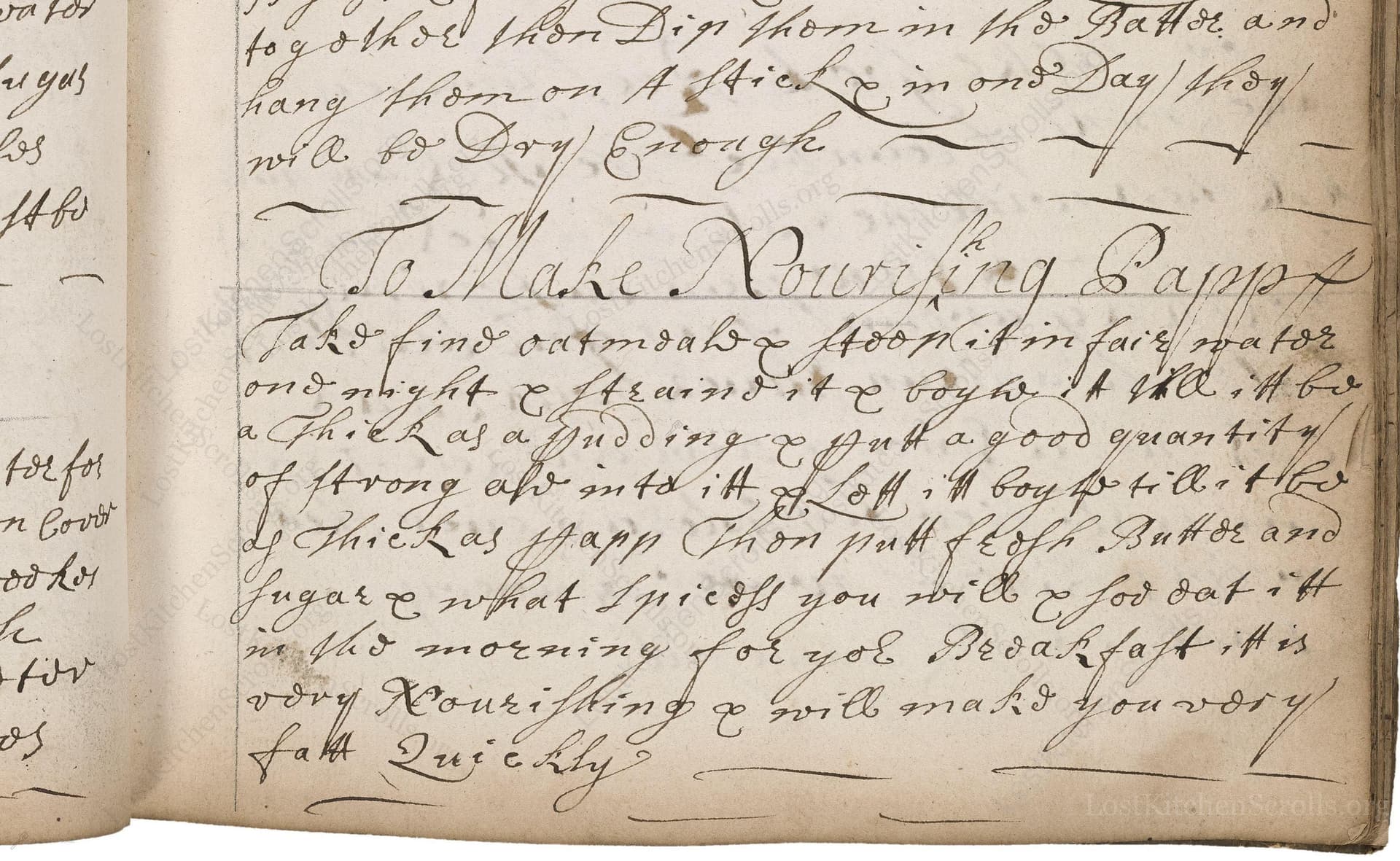To Make Nourishing Papp
From the treasured pages of Cookbook of Ann Smith, Reading
Written by Ann Smith

To Make Nourishing Papp
"Take find oatmeale & Steop it in fair water one night & Strain it & boyle it till it be as Thick as a pudding & putt a good quantity of Strong ale into itt & lett it boyle till it be as Thick as papp Then putt of fresh Butter and Sugar & what Spice you will & Soe Eat it in the morning for you Break fast it is very Nourishing & will make you very fat Quickly"
Note on the Original Text
This recipe is a wonderful specimen of early modern English cookery writing: prose rather than lists, with actions chained together in long sentences. Spelling is irregular for words like 'boyle' (boil), 'papp' (pablum or porridge), and 'Steop' (steep), reflecting the lack of standardized English spelling. The text assumes a cook's intuition for quantities and timings—proportions are 'a good quantity,' spices and sugar 'what you will.' Directions are clear yet flexible, typical of the period when cooks were expected to adapt recipes to their larders and circumstance.

Title
Cookbook of Ann Smith, Reading (1698)
You can also click the book image above to peruse the original tome
Writer
Ann Smith
Era
1698
Publisher
Unknown
Background
Step into the sumptuous kitchens of 17th-century England with Ann Smith’s culinary treasury, where traditional recipes and time-honored techniques invite you to savor the flavors of history. Each page promises a feast of inspiration and a glimpse into the artful dining of a bygone era.
Kindly made available by
Folger Shakespeare Library
This recipe comes from Ann Smith in 1698, a time in late 17th-century England when household handwritten recipe books flourished among literate women. Food was both a comfort and a medicine; nourishing porridge-like dishes such as this were prized for their restorative powers. Ale was safer than water and regarded as nutritious, while oats and butter were hearty staples. The addition of sugar and exotic spices reveals both aspiration and the influence of global trade—the everyday and the luxurious in one humble breakfast pot. 'Papp' was intended for fortification; in an era where body fat was associated with health and wellbeing, a 'very nourishing' papp promised robust good health and, as Ann Smith wryly notes, 'will make you very fat quickly.'

In the 17th century, this recipe would have been made in a large earthenware or iron pot over an open hearth fire. Oatmeal was likely ground fresh, and straining was done with linen cloths or fine sieves. Stirring instruments would have included sturdy wooden spoons or paddles, and ingredients measured by eye or using spoons and cups at hand. The finished papp was served in bowls or deep dishes, eaten with wooden or pewter spoons.
Prep Time
10 mins
Cook Time
15 mins
Servings
4
We've done our best to adapt this historical recipe for modern kitchens, but some details may still need refinement. We warmly welcome feedback from fellow cooks and culinary historians — your insights support the entire community!
Ingredients
- 3.5 oz fine oatmeal
- 1 2/3 cups water
- 1 cup strong ale (substitute: non-alcoholic malty beer if desired)
- 1.5 oz unsalted butter
- 0.9 oz sugar (about 2 tablespoons)
- Spices of choice (e.g. cinnamon, nutmeg, ginger), to taste
Instructions
- To make this nourishing papp, begin the night before by soaking 3.5 oz of fine oatmeal in 1 2/3 cups of cold water.
- Allow it to stand overnight at room temperature.
- In the morning, strain the mixture through a fine sieve or cheesecloth to remove coarse particles.
- Pour the strained liquid into a saucepan and bring it to a gentle boil, stirring continuously until the mixture thickens to a pudding-like consistency.
- Next, add 1 cup of strong ale (such as a good English ale), and continue boiling, stirring frequently, until the mixture thickens further to a creamy, porridge-like papp.
- Then, off the heat, mix in 1.5 oz of unsalted butter until melted, and sweeten with 2 tablespoons (about 0.9 oz) of sugar.
- To finish, add your preferred spices—such as a pinch each of cinnamon, nutmeg, or even ginger—to taste.
- Serve warm as a fortifying breakfast.
Estimated Calories
220 per serving
Cooking Estimates
Soak the oats overnight for about 8 hours. The morning preparation, including straining, cooking, and finishing, takes about 25 minutes. Each serving contains an estimated 220 calories.
As noted above, we have made our best effort to translate and adapt this historical recipe for modern kitchens, taking into account ingredients nowadays, cooking techniques, measurements, and so on. However, historical recipes often contain assumptions that require interpretation.
We'd love for anyone to help improve these adaptations. Community contributions are highly welcome. If you have suggestions, corrections, or cooking tips based on your experience with this recipe, please share them below.
Join the Discussion
Rate This Recipe

Den Bockfisch In Einer Fleisch Suppen Zu Kochen
This recipe hails from a German manuscript cookbook compiled in 1696, a time whe...

Die Grieß Nudlen Zumachen
This recipe comes from a rather mysterious manuscript cookbook, penned anonymous...

Ein Boudain
This recipe comes from an anonymous German-language manuscript cookbook from 169...

Ein Gesaltzen Citroni
This recipe, dating from 1696, comes from an extensive anonymous German cookbook...
Browse our complete collection of time-honored recipes



